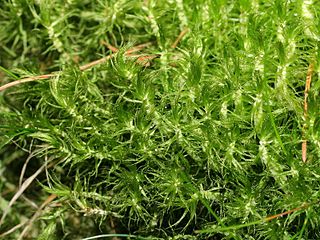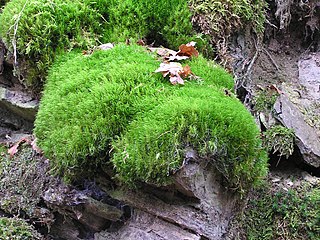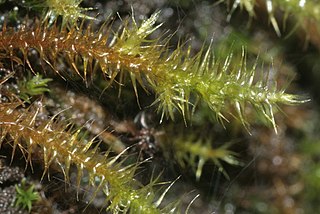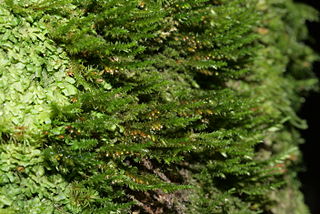
Funaria is a genus of approximately 210 species of moss. Funaria hygrometrica is the most common species. Funaria hygrometrica is called “cord moss” because of the twisted seta which is very hygroscopic and untwists when moist. The name is derived from the Latin word “funis”, meaning "a rope". In funaria root like structures called rhizoids are present.

Dicranum is a genus of mosses, also called wind-blown mosses or fork mosses. These mosses form in densely packed clumps. Stems may fork, but do not branch. In general, upright stems will be single but packed together. Dicranum is distributed globally. In North America these are commonly found in Jack pine or Red pine stands.
Molendoa is a genus of moss in family Pottiaceae.

Dicranaceae is a family of haplolepideous mosses (Dicranidae) in class Bryopsida. Species within this family are dioicous. Genera in this family include Dicranum, Dicranoloma, and Mitrobryum.

Ditrichum is a genus of haplolepideous mosses (Dicranidae) in the family Ditrichaceae.

Amblystegiaceae is a family of mosses. It includes 20 to 30 genera with a total of up to 150 species. They occur nearly worldwide, growing in tropical, temperate, and subpolar regions.

Cryphaea is a genus of mosses, (Bryophyta), containing at least 26 accepted species.

Thuidium is a genus of moss in the family Thuidiaceae. The name comes from the genus Thuja and the Latin suffix -idium, meaning diminutive. This is due to its resemblance to small cedar trees.

Plagiomnium is a genus of mosses in the family Mniaceae. It was formerly a part of a more encompassing genus Mnium and in 1968 Finnish bryologist Timo Juhani Koponen justified splitting the genus into a number of smaller genera.
Timmiellaceae is a family of haplolepideous mosses (Dicranidae). It contains two genera, Luisierella and Timmiella, that were formerly place in family Pottiaceae.

Neckera is a large genus of mosses belonging to the family Neckeraceae. The genus was first described by Johann Hedwig. The genus has a cosmopolitan distribution.

Philonotis is a genus of mosses belonging to the family Bartramiaceae.

Rhynchostegium is a genus of pleurocarpous mosses belonging to the family Brachytheciaceae. The genus has a cosmopolitan distribution across different climatological regions except the polar regions, mostly in tropic to north temperate regions. The genus contains both aquatic and terrestrial species. The genus was named for their rostrate opercula. The type species of this genus is Rhynchostegium confertum (Dicks.) Schimp.

Vesicularia is a genus of mosses belonging to the family Hypnaceae.

Pylaisia is a genus of mosses belonging to the family Pylaisiaceae.

Ptychostomum is a genus of mosses belonging to the family Bryaceae. It has an almost cosmopolitan distribution. It has two subgenera, Psychostomum (Ptychostomum) and Psychostomum (Cladodium).

Distichophyllum is a genus of mosses belonging to the family Daltoniaceae. The species of this genus are found in New Zealand.

Leskeaceae is a family of mosses belonging to the order Hypnales.

Gemmabryum is a genus of moss in the family Bryaceae. It was separated from the genera Bryum and Brachymenium in 2005. It has been argued that the correct name for the genus is Osculatia.

















